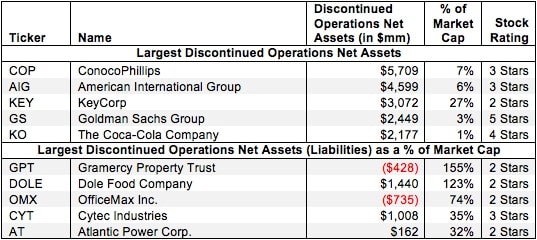This report is one of a series on the adjustments we make to GAAP data so we can measure shareholder value accurately. This report focuses on an adjustment we make to our calculation of economic book value and our discounted cash flow model.
We’ve already broken down the adjustments we make to NOPAT and invested capital. Many of the adjustments in this third and final section deal with how adjustments to those two metrics affect how we calculate the present value of future cash flows. Some adjustments represent senior claims to equity holders that reduce shareholder value while others are assets that we expect to be accretive to shareholder value.
Adjusting GAAP data to measure shareholder value should be part of every investor’s diligence process. Performing detailed analysis of footnotes and the MD&A is part of fulfilling fiduciary responsibilities.
In earlier reports, we discussed how discontinued operations inflate operating profit (NOPAT) andbalance sheets. There is one last adjustment we must make involving discontinued operations: adding net assets from discontinued operations to shareholder value. Because discontinued operations are parts of a company being held for sale, the value of the net assets from these discontinued operations approximate the cash the company will receive from the sale. This cash will then be available for distribution to shareholders.
You can find our aforementioned report on discontinued operations removed from operating profit here, and our report on discontinued operations removed from invested capital here.
ConocoPhilips (COP) is a good example of this adjustment to shareholder value. As a result of the pending sale of its business units in Kazakhstan, Algeria and Nigeria, COP recorded $7.2 billion in discontinued assets and $1.5 billion in discontinued liabilities in 2012. These discontinued operations added net assets of $5.7 billion to COP’s shareholder value. As a result of this adjustment, COP’seconomic book value rose from $98 billion to over $103 billion. The disclosure of these net assets from discontinued operations occurred on page 88 of COP’s 2012 annual filing, deep in the financial footnotes.
Without careful footnotes research, investors would never know that net assets from discontinued operations can increase or decrease the amount of future cash flow available to shareholders.
Figure 1 shows the five companies with the largest amount of discontinued operations net assets added to shareholder value in 2012 and the five companies with the largest amount of discontinued operations net assets adjustment as a percent of market cap.
Figure 1: Companies With the Largest Discontinued Operations Net Assets Added To Shareholder Value
 Sources: New Constructs, LLC and company filings. Excludes stocks with market caps under $100 million.
Sources: New Constructs, LLC and company filings. Excludes stocks with market caps under $100 million.
However, these are far from the only companies that are affected by discontinued operations. In 2012 alone, we found 329 companies with assets from discontinued operations, totaling $37 billion in net assets added to shareholder value and $3 billion in net liabilities subtracted from shareholder value.
Since net assets from discontinued operations increase the amount of cash available to be returned to shareholders, companies with significant net assets from discontinued operations will have a meaningfully higher economic book value when this adjustment is applied. For example, Dole (DOLE) had over $1.4 billion in net assets from discontinued operations added to shareholder value in 2012. This amount raised Dole’s economic book value from -$1.3 billion to $146 million, and its economic book value per share from -$14.42/share to $1.63/share.
Investors who ignore net assets from discontinued operations are not getting a true picture of the cash available to be returned to shareholders. By adding including net assets from discontinued operations, one can better understand the value of the stock to shareholders. Diligence pays.
André Rouillard contributed to this report.
Disclosure: David Trainer and André Rouillard receive no compensation to write about any specific stock, sector, or theme.
